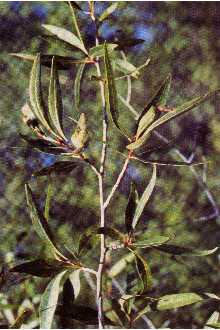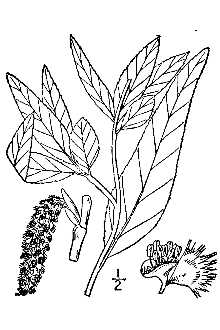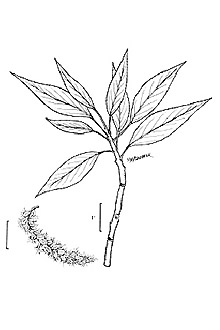Narrowleaf Cottonwood
Scientific Name: Populus angustifolia James

| General Information | |
|---|---|
| Usda Symbol | POAN3 |
| Group | Dicot |
| Life Cycle | Perennial |
| Growth Habits | Tree |
| Native Locations | POAN3 |
Plant Guide
Uses
Industry: Wood of narrow-leaf cottonwood is susceptible to decay and warps when cut into lumber. Because of this and its relative scarcity, it is commercially unimportant – used mostly for fenceposts and fuel, less commonly for crating, boxes, pallets, plywood veneer, and pulpwood; wood shavings are used for bedding, insulation, and animal food supplements. Wildlife: Narrow-leaf cottonwood provides habitat, cover, and food for a diversity of wildlife. Common residents include squirrels, aquatic fur bearers, bears, white-tailed deer, and many bird species. Twigs and leaves are browsed by rabbits, deer, and moose and buds and catkins are eaten by quail and grouse. Beaver cut all sizes of cottonwoods to build and maintain lodges and dams and use the bark for immediate food or storage in winter caches. Conservation: Narrow-leaf cottonwood is planted as a fast-growing ornamental tree in western US cities. These trees can be used at high elevations and are useful in landscaping on deer winter ranges since deer will not damage them through overbrowsing. The species was early encountered (in1805) by the Lewis and Clark expedition, who observed that horses would not eat it. @ PLANTS The aggressively spreading root system of narrow-leaf cottonwood makes it useful for soil stabilization in erosion control and streambank reclamation projects. This same feature, however, may be a liability in urban areas where the roots may clog drains and sewers. Ethnobotanic: Native Americans used young cottonwood shoots to make baskets.
Status
Please consult the PLANTS Web site and your State Department of Natural Resources for this plant’s current status, such as, state noxious status and wetland indicator values.
Description
General: Willow Family (Salicaceae). Native trees up to 15-20 m tall, single-stemmed with slender, upright branches forming a narrowly spreading crown. The bark is yellowish green to grayish brown, smooth on upper portions and furrowed into broad, flat ridges on older lower portions. Leaves are deciduous, simple, alternate, lanceolate to ovate-lanceolate, rounded at base, 5-9(-13) cm long, 1-2.5 cm wide, hairless or nearly so, the margins glandular-toothed, dark green above and slightly paler beneath, turning dull yellow in autumn, the petioles less than 15 mm long, about 1/3 as long as the blade, flattened only near the base. Flowers male (staminate) and female (pistillate), are on separate trees (the species dioecious). Each type is borne in pendent catkins, the female elongating to 6-8 cm long. Fruits are ovoid, pointed capsules 6-8 mm long, splitting to release the seeds; seeds 2-3 mm long, each with a tuft of long, white, silky hairs (“cotton”), easily blown by the wind. The common name is in reference to the slender leaves. Variation within the species: No variants have been recognized within the species, but natural hybrids are frequent between narrow-leaf cottonwood and other species: balsam poplar (P. balsamifera) = P. x brayshawii Boivin (Brayshaw’s poplar); eastern cottonwood (P. deltoides) = P. x acuminata Rydb. (lanceleaf poplar); Fremont cottonwood (P. fremontii) = P. x hinckleyana Correll.
Distribution
Narrow-leaf cottonwood occurs primarily in mountainous areas from southern Alberta and Saskatchewan south to Oregon and California (east of the Sierra Nevada), Arizona, New Mexico, and Trans-Pecos Texas and in northern Mexico (northeastern Sonora). For current distribution, please consult the Plant Profile page for this species on the PLANTS Web site.
Adaptation
Narrow-leaf cottonwood grows along streambanks in dry mountains, desert shrublands, and prairie grasslands and in coniferous forests with willows and alders, at elevations of 900-2450 meters. It is commonly found on narrow, periodically flooded benches adjacent to streams and smaller rivers. Common associates are Douglas-fir, blue spruce, ponderosa pine, Rocky Mountain juniper, maples, birches, alders, other cottonwoods and aspen; in relatively undisturbed sites, the understory often includes red-osier dogwood, chokecherry, serviceberry, willows, and currants. Narrow-leaf cottonwood is a pioneer that colonizes sandbars and other fresh alluvium in areas of full sun. Such sites tend to become dominated by a dense, closed canopy of cottonwood. Continual disturbances such as flood and fire allow such communities to persist. This species flowers in May, before or during leaf emergence and fruits May-July, with seed dispersal in June-July.
Establishment
Flowering begins at about 15 years in narrow-leaf cottonwood, Use soil moisture sensors to measure the soil moisture of Narrowleaf Cottonwood., Male and female trees must be grown in proximity if seed is desired, Large seed crops are produced each year but seeds are viable for probably no more than 3 weeks, They establish only if they land on unoccupied, wet, sandy soil in full sun, Flood disturbance along waterways enhances seedling recruitment, and periodic fires may serve the same purpose – removing competing conifers, allowing more light penetration, and exposing mineral soil, Narrow-leaf cottonwood is a fast-growig but short-lived species in natural conditions, Narrow-leaf cottonwood reproduces vegetatively by sprouting from roots and stumps,
Management
Because of its short period of viability, seed needs to be sown within a few days of ripening in the spring. Otherwise they may be kept viable by drying and storing cold in an airtight container. In a cold frame, sow on the surface or lightly cover the seeds. Plant into permanent positions either in late summer or the following spring, depending on growth of the young plants. Cuttings of twigs 20–45 cm long and 1-3 cm diameter of the current season's growth, taken during the dormant season, can be placed in a sheltered outdoor bed or directly into permanent positions. Initial growth of un-rooted cuttings may not be as rapid as that of rooted cuttings. Cuttings grown in a mist-propagator also root easily and survive potting. Nursery- or container-grown seedlings and rooted cuttings establish easily and grow rapidly on moist well-drained soils in full sun. Growth may be minimal on wet soils and upland sites. Beaver activities may inhibit cottonwood regeneration; seedlings and saplings are stripped of bark for food and larger trees are cut for building material. Poorly oxygenated water in stagnant ponds causes a decline in health. Severe grazing by livestock, and associated trampling of seedlings, reduces cottonwood regeneration potential. The aggressive root systems can invade and damage drainage systems and also may heavily draw available moisture from gardens and building foundations, especially in clay soil. Root suckers also may be considered a maintenance problem, and the profuse production of cottony seed from female plants can be a minor nuisance. Narrow-leaf cottonwood will produce stump sprouts and root suckers after light to moderate intensity fires. Seedlings, saplings, and young trees are damaged or killed by fire, but they develop more fire-resistant bark after 15-20 years of age. Older trees may be killed by even relatively cool fires, which wound trees and open the way to heartwood decay. Where spruce is climax, periodic fire may contribute to the maintenance of cottonwood stands, but mature bottomland hardwood stands will not persist in the face of fire. Cultivars, Improved and Selected Materials (and area of origin) Contact your local Natural Resources
Conservation
Service (formerly Soil Conservation Service) office for more information. Look in the phone book under ”United States Government.” The Natural Resources Conservation Service will be listed under the subheading “Department of Agriculture.”
References
Eckenwalder, J.E. 1977. North American cottonwoods Populus (Salicaceae) of sections Abasco and Aigeros. J. Arnold Arb. 58:193-207. Eckenwalder, J.E. 1989. Natural intersectional hybridization between North American species of Populus (Salicaceae) in sections Aigeros and Tacamahaca. II. Taxonomy. Canad. J. Bot. 62:325-335. Harris, H.T. 1989. Populus angustifolia. IN: W.C. Fischer (compiler). The fire effects information system [Data base]. USDA, Forest Service, Intermountain Research Station, Intermountain Fire Sciences Laboratory, Missoula, Montana. SEP00. Lanner, R.M. 1983. Trees of the Great Basin: A natural history. Univ. of Nevada Press, Reno, Nevada.
Plant Traits
Growth Requirements
| Temperature, Minimum (°F) | -28 |
|---|---|
| Adapted to Coarse Textured Soils | Yes |
| Adapted to Fine Textured Soils | No |
| Adapted to Medium Textured Soils | Yes |
| Anaerobic Tolerance | Medium |
| CaCO3 Tolerance | High |
| Cold Stratification Required | No |
| Drought Tolerance | Low |
| Fertility Requirement | Low |
| Fire Tolerance | Medium |
| Frost Free Days, Minimum | 115 |
| Hedge Tolerance | Low |
| Moisture Use | High |
| pH, Maximum | 7.5 |
| pH, Minimum | 6.0 |
| Planting Density per Acre, Maxim | 700 |
| Planting Density per Acre, Minim | 300 |
| Precipitation, Maximum | 35 |
| Precipitation, Minimum | 20 |
| Root Depth, Minimum (inches) | 12 |
| Salinity Tolerance | Medium |
| Shade Tolerance | Intolerant |
Morphology/Physiology
| Bloat | None |
|---|---|
| Toxicity | None |
| Resprout Ability | Yes |
| Shape and Orientation | Erect |
| Active Growth Period | Summer |
| C:N Ratio | High |
| Coppice Potential | Yes |
| Fall Conspicuous | Yes |
| Fire Resistant | No |
| Flower Color | White |
| Flower Conspicuous | Yes |
| Foliage Color | Green |
| Foliage Porosity Summer | Dense |
| Foliage Porosity Winter | Porous |
| Foliage Texture | Medium |
| Fruit/Seed Conspicuous | Yes |
| Nitrogen Fixation | None |
| Low Growing Grass | No |
| Lifespan | Moderate |
| Leaf Retention | No |
| Known Allelopath | No |
| Height, Mature (feet) | 60.0 |
| Height at 20 Years, Maximum (fee | 60 |
| Growth Rate | Rapid |
| Growth Form | Single Stem |
| Fruit/Seed Color | White |
Reproduction
| Vegetative Spread Rate | Slow |
|---|---|
| Small Grain | No |
| Seedling Vigor | Low |
| Seed Spread Rate | Rapid |
| Seed per Pound | 1000000 |
| Fruit/Seed Persistence | No |
| Propagated by Tubers | No |
| Propagated by Sprigs | No |
| Propagated by Sod | No |
| Propagated by Seed | Yes |
| Propagated by Corm | No |
| Propagated by Cuttings | Yes |
| Bloom Period | Spring |
| Commercial Availability | Routinely Available |
| Fruit/Seed Abundance | High |
| Fruit/Seed Period Begin | Summer |
| Fruit/Seed Period End | Summer |
| Propagated by Bare Root | Yes |
| Propagated by Bulb | No |
| Propagated by Container | Yes |
Suitability/Use
| Veneer Product | No |
|---|---|
| Pulpwood Product | Yes |
| Protein Potential | Low |
| Post Product | Yes |
| Palatable Human | No |
| Palatable Graze Animal | High |
| Palatable Browse Animal | Medium |
| Nursery Stock Product | Yes |
| Naval Store Product | No |
| Lumber Product | Yes |
| Fuelwood Product | Low |
| Fodder Product | No |
| Christmas Tree Product | No |
| Berry/Nut/Seed Product | No |


